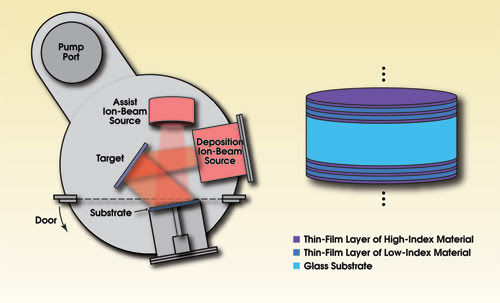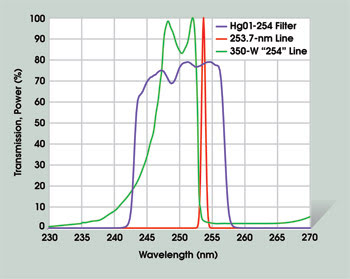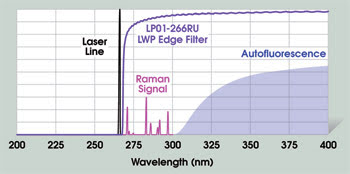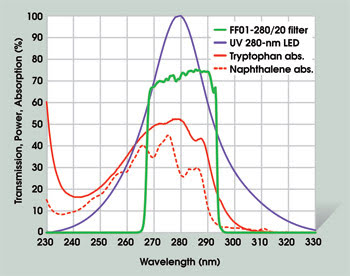A new generation of optical filters benefits optical applications in the mid-UV.
Dr. Turan Erdogan and Dr. Atul Pradhan, Semrock Inc.
The importance of optical applications in the middle-ultraviolet spectral region — between about 200 and 320 nm — continues to increase with the advent of new excitation light sources in this range, also identified as the UVC (200 to 280 nm) and UVB (280 to 320 nm) bands. Examples of new sources include more efficient mid-UV lasers, AlGaN LEDs and more conventional broadband sources such as high-pressure mercury and xenon arc lamps with improved efficiency and longer lifetimes.
A major impediment that continues to make the mid-UV an optically challenging spectral region is the lack of durable optical filters with adequate performance. However, optical filters constructed from thin-film coating materials that have relatively low absorption and spectral dispersion yet high reliability at these short wavelengths would have significant advantages over components such as the diffraction gratings used in monochromators and spectrophotometers.
In general, grating-based systems are not as selective and do not achieve as much throughput as filter-based systems, and only filters allow direct imaging. Until recently, optical filters for the mid-UV have exhibited poor performance in terms of transmission, spectral selectivity and durability. Optical filters made with soft-coated thin-film materials and/or multiple laminated absorbing and transparent glass substrates cannot withstand the intense energies of illumination at mid-UV wavelengths. Hybrid metal-dielectric filters also have poor optical damage thresholds, and inadequately low transmission and edge steepness.
Optical filters with good performance in the mid-UV are crucial for enabling important new instruments based on applications including biochemical absorption, fluorescence and spectroscopy, as well as for realizing the full potential of industrial applications in areas including UV sterilization, and semiconductor and electronics manufacturing.
Deposition of UV filters
Modern thin-film interference filters made with dense hard-oxide dielectric coatings and with transmission bands in the visible and infrared wavelength regions are now well established (see “Thin Film Filters Come of Age,” Photonics Spectra, July 2003, page 94). The highest-performance filters are made using advanced coating deposition techniques, such as ion-assisted ion- beam sputtering, and the materials are hard refractory oxides with indexes of refraction in the range of about 1.45 to 2.35.
Ion-beam-sputtering deposition involves a high-energy beam of ions that is generated by a gridded or other type of ion source and directed at a metal or metal-oxide target. With sufficient energy, atoms are sputtered from the surface of the target, where they subsequently migrate and then deposit onto a nearby glass substrate by random diffusion (Figure 1). The deposition is further assisted by a secondary ion gun, which accelerates a mixture of inert ions directly onto the substrate to densify and compact the coating films. O2+ ions often are introduced into the deposition region near the surface of the glass substrate to control the stoichiometry of the oxide films.

Figure 1. Advanced optical filters for mid-UV wavelengths now can be made with ion-assisted ion-beam sputtering (left). One ion gun is directed at a target to sputter the target material to the substrate, and a second is directed at the substrate itself to control the surface chemistry and densify the hard-oxide coating. In this way, multilayer thin-film coatings can be deposited with high durability and low loss on a single glass substrate to produce complex optical filters (right).
Deposition of thin-film materials with transmission in the UV presents challenges such as a greater degree of absorption of refractory materials at these wavelengths and a high variation in refractive index. These properties are true of all oxide coating materials that may be used in the mid-UV, including Al2O3, HfO2, Ta2O5, Sc2O3 and Y2O3.
To attain the desirable attributes of high transmission, deep out-of-band blocking and sharp cut-on and cut-off passband edges, many layers must be deposited. High-performance filters in the visible and near-infrared are made now with many hundreds of layers. Even minute levels of absorption and index variation errors can result in severely degraded transmission and spectral profiles relative to the desired target values. Controlling these variables requires careful consideration and monitoring of the stoichiometry of the deposited materials. Deposition challenges at UV wavelengths are further exacerbated because of the physical thinness of the film layers, requiring tighter tolerances on layer deposition timing.
UV radiation is particularly challenging for optical systems because the transmission and refractive index of many optical materials can degrade rapidly when exposed to intense UV illumination, as a result of solarization. Colored glasses are particularly susceptible to photodarkening and even cracking under typical high-intensity illumination conditions, so optical system designers often must resort to significantly expanded UV beam sizes with oversize optical filters to reduce the intensity of light and to minimize photodegradation of the filters. These measures greatly increase the cost of an optical system. In contrast, hard-oxide UV filters made by ion-beam sputtering have been shown to exhibit no significant change in transmission or index of refraction even after thousands of hours of exposure to intense UV illumination in the mid-UV-wavelength range.
Mercury line illumination
Hard-oxide UV filters can benefit applications that involve mercury arc lamps. Low-pressure mercury arc lamps emit radiation at powerful resonance lines, such as 254 nm in the mid-UV. As shown in Figure 2, practical spectra of the 254-nm mercury line in higher-power (higher-pressure) light sources can exhibit a significant amount of collisional and Doppler line broadening as well as line-center absorption leading to self-reversal. These lamps are used for a variety of annealing and curing applications, for electroless plating, and for electrochemical oxidation processes in electronics and printed circuit board manufacturing.

Figure 2. Typical spectra of both low- and high-pressure mercury arc lamps at 254 nm are overlaid on the spectrum of a mercury line filter. The filter has greater than 70 percent transmission and excellent discrimination of all other mercury lines as well as the broad background radiation.
A broadband source featuring the 254-nm mercury line with a suitably wide filtered bandwidth (Figure 2) also is useful for prototype, research-oriented and small-scale photolithography applications, particularly those involving catadioptric or largely reflective systems and direct-contact-mask photolithography.
These optical systems can take advantage of the wavelength-dependent improvement in resolution despite the fact that the 254-nm line is significantly less intense than the traditionally utilized 365-nm mercury “i-line.”
Filters that pass UV light in the Hartley bands of ozone (230 to 290 nm) and that block longer-wavelength contaminating solar radiation are important for so-called “solar blind” UV detection. Because solar radiation in the Hartley bands is so strongly absorbed, essentially no solar radiation reaches the Earth’s surface at these wavelengths. Filters for this application traditionally have been metal-dielectrics, which have very poor transmission. The high transmission of the new class of ion-beam-sputtered hard-oxide coating filters, a substantial performance improvement, is now possible in a wide variety of critical solar-blind applications, including electrical discharge, arcing and corona detection for the utility market and fiber optic communications; monitoring of polycyclic aromatic hydrocarbons at petrochemical facilities; and flame and combustion chemistry analysis.
UV Raman spectroscopy
Some of the most challenging applications for optical filters in the mid-UV are Raman and native-fluorescence “standoff” (remote) detection and classification of trace levels of chemical hazards. When excitation wavelengths are near or below 250 nm, Raman and native-fluorescence emission bands occur in different spectral regions for nearly all materials, enabling sensors that employ exclusive detection of Raman signals with no fluorescence interference, or even simultaneous detection of both Raman and native-fluorescence emissions to identify unknown substances. Detection in the mid-UV takes advantage of resonance signal enhancements from a wide array of organic materials, virtually eliminates fluorescence background emission from the target or surrounding materials, and enables solar-blind standoff detection during full sunlight conditions.
Success in achieving these goals depends heavily on the ability of optical filters to block scattering at the laser excitation wavelength (optical density >6), to transition sharply from the blocked laser wavelength to high transmission in the Raman detection bands, to block unwanted light above the Raman and fluorescence bands to the long wavelength extent of the detectors used in the sensor, and to exhibit no intrinsic fluorescence when exposed to the mid-UV laser wavelength.
For mid-UV edge filters, the transition from high blocking to high transmission must occur in typically less than 3 to 4 nm to achieve detection of Raman scattering less than about 500 cm21. A small amount of filter leakage at any undesired wavelength can seriously degrade the performance of the sensor, especially for spontaneous Raman scattering. Figure 3 shows an example of the measured transmission spectrum of a steep-edge filter made by modern ion-beam-sputtering deposition and hard-oxide coating materials, overlaid on representative spectra (not to relative vertical scale) of a 266-nm laser line, several Raman lines, and near-UV and visible autofluorescence.

Figure 3. A new steep and highly transmitting long-wave-pass edge filter blocks the 266-nm line of a quadrupled Nd:YAG laser with optical density greater than 6, while transmitting Raman signals from wavelengths as short as 268 nm to about 300 nm and fluorescence at near-UV and visible wavelengths.
Recently, an increasing number of compact, affordable and high-power mid-UV lasers have become widely available, such as quadrupled diode-pumped Nd:YAG lasers at 266 nm and lasers that emit at 248.6 and 224.3 nm. Photon Systems Inc. has developed these shorter-wavelength lasers, which are miniature hollow-cathode metal-ion devices. They have linewidths of <4 pm, produce output power higher than 500 mW, weigh less than 1 lb and consume less than 5 W of total power. When these lasers are combined with the new ion-beam-sputtered thin-film filters, including Semrock’s high-performance RazorEdge long-wave pass and MaxLine laser-line types, ultrasensitive mid-UV Raman spectroscopy is a much more widely accessible technique.
Fluorescence spectroscopy
The basis of many spectroscopic applications for UV optical filters is that the electronic structure of certain molecules gives rise to absorption in the mid-UV resulting from radiative transitions that involve double-bonded (bonding-antibonding) orbitals. For example, nucleotide bases show absorption at roughly 260 nm, and fluorescent amino acids such as tryptophan exhibit absorption at 280 nm.
Proteins are basic building blocks of biological organisms and are involved in many biochemical processes. They contain all three fluorescent amino acid residues (tryptophan, tyrosine and phenylalanine) and are, therefore, inherently fluorescent. Thus, they may be measured or imaged with high specificity using standard fluorescence imaging techniques and without the need for indirect fluorescent labeling procedures.

Figure 4. Spectra of two important molecules that exhibit strong absorbance peaks in the mid-UV are shown as well as a typical 280-nm LED spectrum and that of a high-performance optical filter made using ion-beam-sputtering deposition. The filtered LED source is ideal for efficient absorption and fluorescence detection at wavelengths immediately adjacent to the source spectrum (>300 nm).
Figure 4 shows the absorbance of the amino acid tryptophan along with that of another example of an important molecule containing aromatic rings (naphthalene), the spectral profile of a commercially available AlGaN LED that peaks around 280 nm, and a new high-transmission excitation bandpass filter. This class of thin-film filters is made with ion-beam-sputtering deposition using hard-oxide coating materials. It achieves greater than 70 percent transmission with very steep edges and high out-of-band blocking. By comparison, metal-dielectric filters typically have only 10 to 15 percent transmission in the mid-UV, lower blocking in neighboring bands, and edges that require tens of nanometers to go from high transmission to the blocking regions.
Absorption of mid-UV light by proteins and detection of the fluorescence emission in the 300- to 400-nm range are used to characterize tissue autofluorescence for cancer detection applications. For an optical filter such as the 280-nm bandpass type to function as an excitation filter for high signal-to-noise-ratio fluorescence measurements, it must have deep blocking over the emission spectrum of the fluorophore (optical density >5) as well as throughout the full visible spectrum to block stray light that could swamp the fluorescence signal.
Acknowledgment
The authors thank Bill Hug of Photon Systems Inc. for his generous contributions to this article.
Meet the authors
Turan Erdogan is chief technology officer and Atul Pradhan was principal optical engineer, both at Semrock Inc. in Rochester, N.Y.